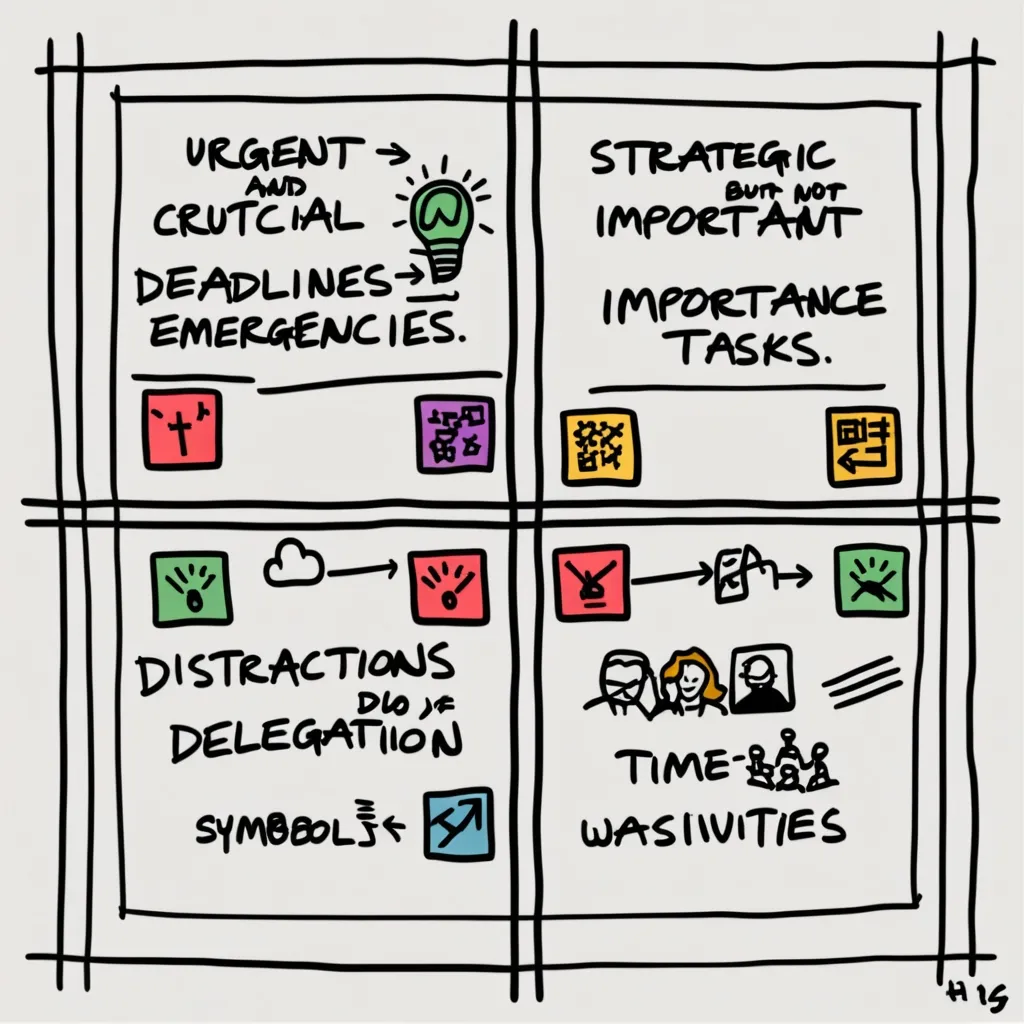In today’s whirlwind of responsibilities and never-ending to-do lists, mastering time management is like possessing a secret key to reducing stress and reaching personal goals. One method that stands out is the Eisenhower Matrix—a nifty framework for deciding which tasks deserve attention based on their urgency and importance. Named after former U.S. President Dwight D. Eisenhower, the matrix roots from his belief that “what is important is seldom urgent and what is urgent is seldom important.” A neat way to structure the chaos, for sure!
The Eisenhower Matrix is pretty simple but revolutionary. Picture a straightforward grid with two main paths: urgency and importance. Together, they split into four quadrants, each defining a different breed of task that claims a spot on your agenda.
Tasks that scream for attention right away and carry weighty consequences belong in Quadrant 1—these are the genuine showstoppers. They’re the emergencies and pressing deadlines that keep the wheels turning. It’s here you find things like crucial project deadlines or needing to fix a broken pipe. There’s no room to slack with these; they demand action pronto.
A step down the urgency ladder is Quadrant 2, where important tasks without an immediate fire burning beneath them reside. These might not scream for attention now but are essential over the long haul. Consider planning a new project, learning something new, or tackling a strategic task. They’re the ticket to future success; focus on scheduling these in without delay.
Then there’s Quadrant 3, home to tasks drowning in urgency but lacking real importance. Think of the little distractions that fill the day—irrelevant emails, unnecessary meetings, or the siren call of social media. These are best passed off to someone else if possible—not exactly the realm of crucial work but still needing a some attention.
Finally, Quadrant 4, the land of the neither-urgent-nor-important. Here lurk time-sucking activities that keep you from caring for the important things in life—like hours lost binge-watching TV or playing video games. Sure, downtime is crucial, but too much of it can derail productivity. It’s best to curtail these whenever you notice them taking over.
Getting started with the Eisenhower Matrix is straightforward. Jot down all tasks swirling in your mind, from work projects to personal chores, and place them on a piece of paper or a digital document. Then, each task earns its quadrant based on its urgency and importance.
Once organized, take action:
- Quadrant 1 tasks? Immediate action is non-negotiable.
- Quadrant 2 tasks? Schedule them with the seriousness they deserve.
- Quadrant 3 tasks? Hand them over if you can.
- Quadrant 4 tasks? These are prime candidates for a swift toss in the trash.
To spice up the process and make the matrix more user-friendly, some opt for color-coding. A simple system like green for urgent and critical tasks, yellow for essential tasks waiting their turn, blue for tasks suitable for delegation, and red for the time-wasting activities can work wonders. It’s also wise to constrain the number of tasks living in each quadrant—about 10 should do it—to prevent chaos from taking the wheel again.
Creating separate matrices for personal and professional tasks can keep things tidy and focused, especially when managing different timelines and resources. And remember, the Eisenhower Matrix isn’t a one-off deal. It should be regularly updated to mirror the ever-changing nature of your tasks and priorities. You’ll find it’s an ongoing ally, not a static tool.
Applying this method in real life brings clarity. For a project manager juggling countless tasks, the deadline-driven projects live squarely in Quadrant 1. Meetings with little impact but scheduled to break your flow fall in Quadrant 3, while a coming-up report finds its home in Quadrant 2. Social media posts? Definitely Quadrant 4 or delegated elsewhere!
For personal life, envision fixing that leaky faucet as Quadrant 1 while planning a much-needed vacation slots into Quadrant 2. Weighing down Quadrant 3 could be trivial text responses, while a new TV series that’s calling your name sits sadly in Quadrant 4.
It’s also a lifesaver when escaping the illusion of urgency—the bait of temperatures tasks that appear pressing but don’t aid your larger goals. The matrix sharpens focus, slicing through illusion to reveal what really matters. It’s like having the ability to clear away clutter and fill your calendar with targeted tasks that drive meaningful progress.
Beyond managing time, the Eisenhower Matrix is a decision-making guru. It helps keep eyeballs on tasks with the biggest impact and aligns with overarching life goals. Less stress from overwhelming workloads, and clearer pathways are just the beginning benefits of driving sharper focus through this matrix. It doesn’t just help you decide; it’s about marshalling resources and energy to take on what really counts.
In conclusion, the Eisenhower Matrix profoundly transforms the productivity game. By categorizing tasks by urgency and importance, it guides decisions and clarifies focus on what truly matters. Whether handling a bustling work schedule or navigating personal responsibilities, it proves invaluable—helping to reach goals efficiently and effectively. It’s definitely worth a shot, and don’t be surprised—watch as it steers you toward better productivity and success.






